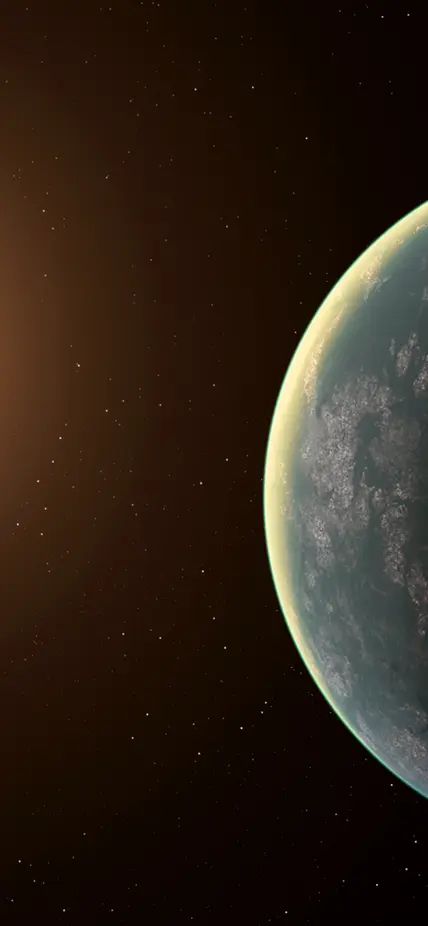Sometimes there is more to a planetary system than initially meets the eye.
Ground-based observations following up on the discovery of a small planet by NASA’s Transiting Exoplanet Survey Satellite (TESS) revealed two additional planets in the same system, one of which is located far enough from its star to be potentially habitable. These findings were announced in Astronomy & Astrophysics by an international team that included several Carnegie astronomers and instrumentation specialists.
The newly found exoplanets orbit a star named GJ 357, an M-type dwarf that’s about one-third of the Sun’s mass and located 31 light-years away in the Hydra constellation. In February, TESS cameras caught the star dimming slightly every 3.9 days, revealing the presence of an exoplanet transiting or passing across its face and dimming its light in every orbit.
The transits that TESS observed belong to GJ 357 b, a planet about 80 percent more massive than Earth and about 22 percent larger in size. It orbits 11 times closer to its star than Mercury does our Sun. This gives it an equilibrium temperature of around 490 degrees Fahrenheit (254 degrees Celsius), leading the team to call it a “hot Earth.” They say these conditions make it one of the best exoplanets discovered to date for research on exoplanet atmospheric compositions.
To confirm the TESS-detected planet’s presence, the discovery team, which was led by Rafael Luque of the Institute of Astrophysics of the Canary Islands on Tenerife, used additional data from ground-based observatories, which revealed two additional, non-transiting planets.
“In a way, these planets were hiding in measurements made at numerous observatories over many years,” Luque said. “It took TESS to point us to an interesting star where we could uncover them.”
These additional worlds were found by measurements using the radial velocity method of exoplanet detection, which takes advantage of that fact that not only does a star’s gravity influence the planet orbiting it, but the planet’s gravity also affects the star in turn. This creates tiny wobbles in the star’s orbit that can be detected using advanced instruments, such as the Planet Finder Spectrograph on one of the Magellan telescopes at Carnegie’s Las Campanas Observatory in Chile.
“Because it is a nearby M dwarf, which we know often host small planets, the PFS team started monitoring this star in 2016,” explained Carnegie’s Johanna Teske. “As soon as we saw that TESS had indeed detected a small transiting planet, we accelerated our PFS observing campaign.”
The mission’s goal of determining the masses of 50 small planets necessitates collaborations with ground-based observatories like Las Campanas, since planet mass is not a parameter that TESS measures.
Carnegie’s Sharon Wang noted, “This planetary system helps demonstrate how crucial tools such as the PFS are for TESS’ success.”
All of PFS team members—which also includes Fabo Feng, Paul Butler, Jeff Crane, and Stephen Shectman—are co-authors on the paper announcing the discoveries.
GJ 357 c, which has a mass at least 3.4 times Earth’s, orbits the star every 9.1 days at a distance of a bit more than twice its sibling GJ 357 b. It has an equilibrium temperature of around 260 Fahrenheit (127 Celsius).
GJ 357 d, the system’s farthest-known planet, has a mass at least 6.1 times Earth’s, and orbits the star every 55.7 days at a distance of about 20 percent of that between Earth and the Sun. The planet’s size and composition are unknown, but with an equilibrium temperature of -64 Fahrenheit (-53 Celsius), the planet seems more glacial than habitable. Future studies are needed to determine if it has a dense atmosphere, but if so, it could trap enough heat to warm its surface enough to host liquid water.
Studying the detailed composition of the atmospheres of nearby exoplanets will be a task for NASA’s James Webb Space Telescope, slated to launch in 2021, and by the new generation of so-called “extremely large” ground-based telescopes now under construction, including the Giant Magellan Telescope, which is being built at Las Campanas.
Top Image Caption: An artist’s illustration of the GJ357 system, courtesy of Carl Sagan Institute/Jack Madden.
__________________
TESS is a NASA Astrophysics Explorer mission led and operated by MIT in Cambridge, Massachusetts, and managed by NASA's Goddard Space Flight Center. Additional partners include Northrop Grumman, based in Falls Church, Virginia; NASA’s Ames Research Center in California’s Silicon Valley; the Harvard-Smithsonian Center for Astrophysics in Cambridge, Massachusetts; MIT’s Lincoln Laboratory; and the Space Telescope Science Institute in Baltimore. More than a dozen universities, research institutes and observatories worldwide are participants in the mission.
